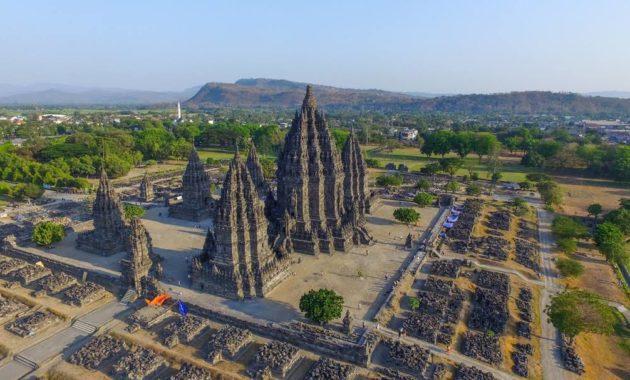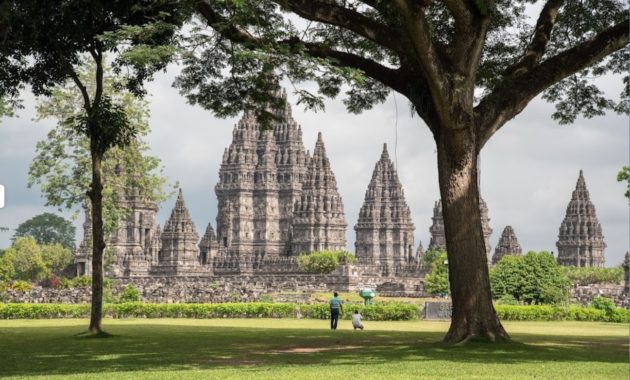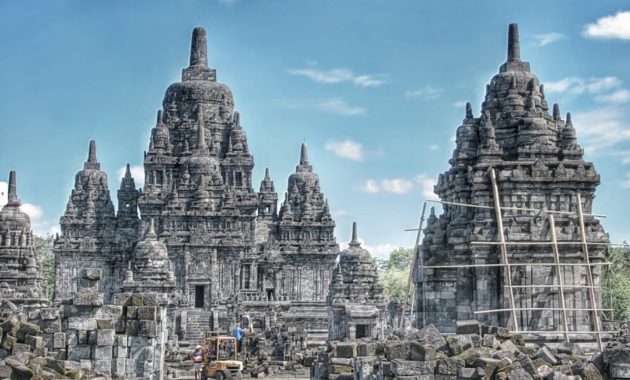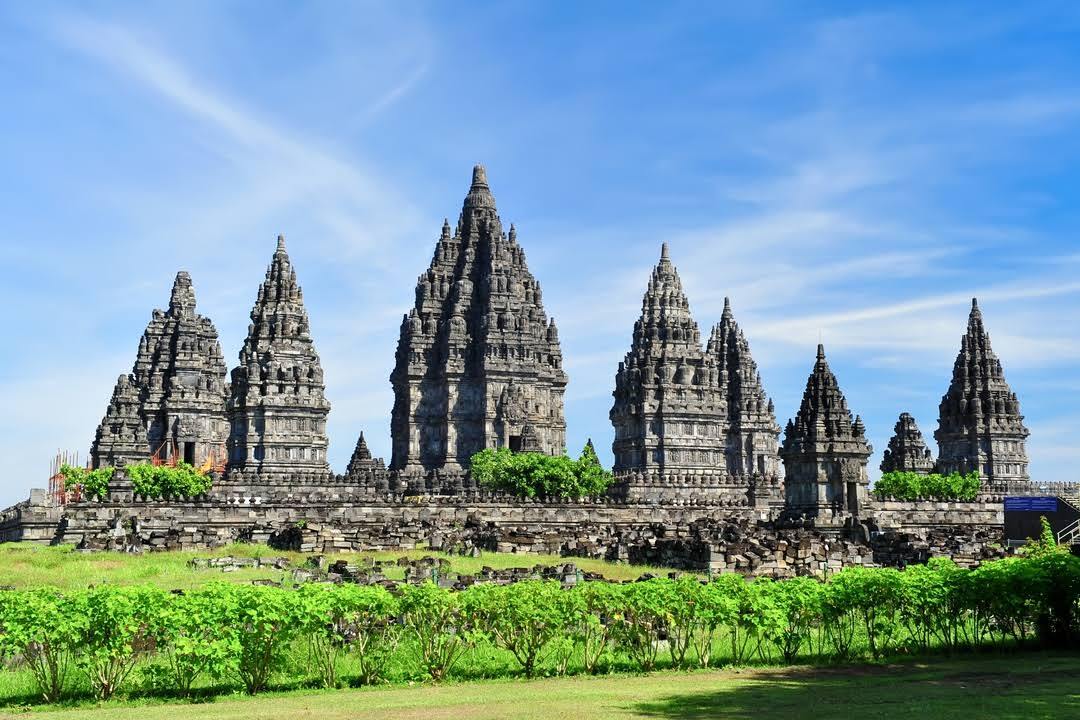History of Prambanan Temple – Prambanan Temple is a Hindu-style temple complex in Sleman, Yogyakarta. This temple is also known as Roro Jonggrang Temple. Prambanan Temple is the largest Hindu temple complex in Indonesia. The history of this temple was first built in the 9th century AD during the Mataram or Medang Kingdom.
According to the Siwagrha inscription, the original name of this temple is Siwagrha Temple, which in Sanskrit means Shiva’s House. This temple was built as an offering to the Trimurti, the three primary Hindu gods, Brahma, Vishnu, and Shiva. But indeed, Lord Shiva is preferred in this temple.
Prambanan Temple is located in Prambanan District, Sleman Regency, Yogyakarta and Prambanan District, Klaten Regency, Central Java. This temple is located between 2 sub-districts from 2 different provinces. This means that this temple is situated on the border of Central Java and Yogyakarta provinces. Click here to see the Prambanan temple on the maps.
Prambanan Temple is a UNESCO World Heritage Site. This temple is claimed to be the largest Hindu temple in Indonesia and one of the most beautiful temples in Southeast Asia. As a cultural heritage, this temple is one of the tourist attractions visited by local and foreign tourists every year.
History of Prambanan Temple
The following will explain in detail the history of Prambanan Temple, starting from the origin and background of the temple, the development process, the legend that developed in the community, and the rediscovery and restoration of the damaged temple building.
The Origin of Prambanan Temple
The history of this Prambanan temple began when the archipelago was still in the era of the Hindu-Buddhist Kingdom. Rakai Pikatan initiated the construction of this temple. He tried to build a magnificent Hindu-style temple to match the Buddhist-style Borobudur Temple that had been built previously.
The construction of the Prambanan temple is also thought to be aimed at marking the return of the Sanjaya family to power in Java. Indeed, there was a rivalry between the Sanjaya dynasty, who were Hindus, and the Buddhist Sailenda dynasty regarding their power in Java.
The temple’s construction became a transition from a Buddhist to a Hindu style in the Mataram or Medang Kingdom. Prambanan Temple was also built to glorify Lord Shiva. The original name of this building in Sanskrit is Siwagrha Temple or Siwalaya Temple.

Prambanan Temple Construction Process
The temple building was first built around 850 AD by Rakai Pikatan. Then successive kings, such as King Lokapala and King Balitung Mah Sambu, continued the development process. The building method is also accompanied by changes in the water system and the areas around the temple so that the temple is more awake.
The temple complex was built periodically and continued by kings such as King Daksa and King Tulodong. Hundreds of additional temples were also built around the main temple as a companion temple.
After that, a very magnificent temple building was formed. The splendor of the Prambanan temple also received wide acceptance from the people of that era. This temple is dedicated to Trimurti, the three primary Hindu gods: Brahma as the creator god, Vishnu as the preserver god, and Shiva as the destroyer god.
Inside the Shiva temple as main temple, there is a Shiva statue in the garbhagriha or main room. Archaeologists believe that the statue is a statue of the embodiment of King Balitung.
The splendor of this temple makes Prambanan the great temple of the Mataram Kingdom. Prambanan Temple is a meeting place for rituals and important royal ceremonies. Also, read The History of Borobudur Temple and Its Origin Story.
The Legend of Prambanan Temple
Prambanan Temple was abandoned around 930 AD. This is most likely caused by the violent eruption of Mount Merapi in the north of the Prambanan temple. The capital of the Mataram kingdom was moved to East Java by Mpu Sindok, who later founded the Isyana dynasty.
Another possible cause for the transfer of the capital is a war or power struggle. As a result, the Prambanan temple needed to be addressed. The temple building began to crumble and collapse. The Prambanan temple became increasingly damaged after an earthquake in the 16th century.
After the split of the Mataram Sultanate in 1755 AD, the ruins of this temple became the boundary between the Yogyakarta Sultanate and the Surakarta Sunanate. At that time, many residents knew about the existence of this temple but needed to learn its history and origin.
At that time, myths and fairy tales were developed about the origin of the temple’s existence. The fairy tale tells the story of thousands of temples built in one night with the help of spirits at the request of Rara Jonggrang’s daughter, but then the princess was cursed to become a statue for cheating.
The story became so famous that the temple is known as Roro Jonggrang Temple. Even today, the story of the temple’s construction in 1 night is still widely told as part of the legend of the community.

Discovery and Restoration of Prambanan Temple
CA later discovered Prambanan Temple. Lons from the Netherlands in 1733. This temple also attracted the attention of many circles during the British occupation of Java. Governor General Sir Thomas Stamford Raffles then ordered further investigation of the ruins of this temple.
Then around 1855, a massive demolition was carried out to restore the temple building. Even so, residents took many statues and temple stones carelessly. The severe restoration of the Prambanan temple only began in the 1930s.
Dutch archaeologists carried out the temple’s renovation and then continued with native Indonesians. Restoration efforts continue to be carried out even today. The restoration of the Shiva temple, the main temple of the complex, was completed in 1953 and inaugurated by President Soekarno.
In 1991, Prambanan Temple was officially included in the World Heritage Site protected by UNESCO. Some parts of the temple continue to be maintained and restored, especially after the Yogyakarta earthquake 2006, which damaged several statues and temple buildings.
So that’s a brief explanation of the history of the Prambanan temple and the origin of the Prambanan temple in full. Currently, Prambanan temple is also one of the tourist attractions visited by many local and foreign tourists—so many references to the history of the Prambanan temple this time.


